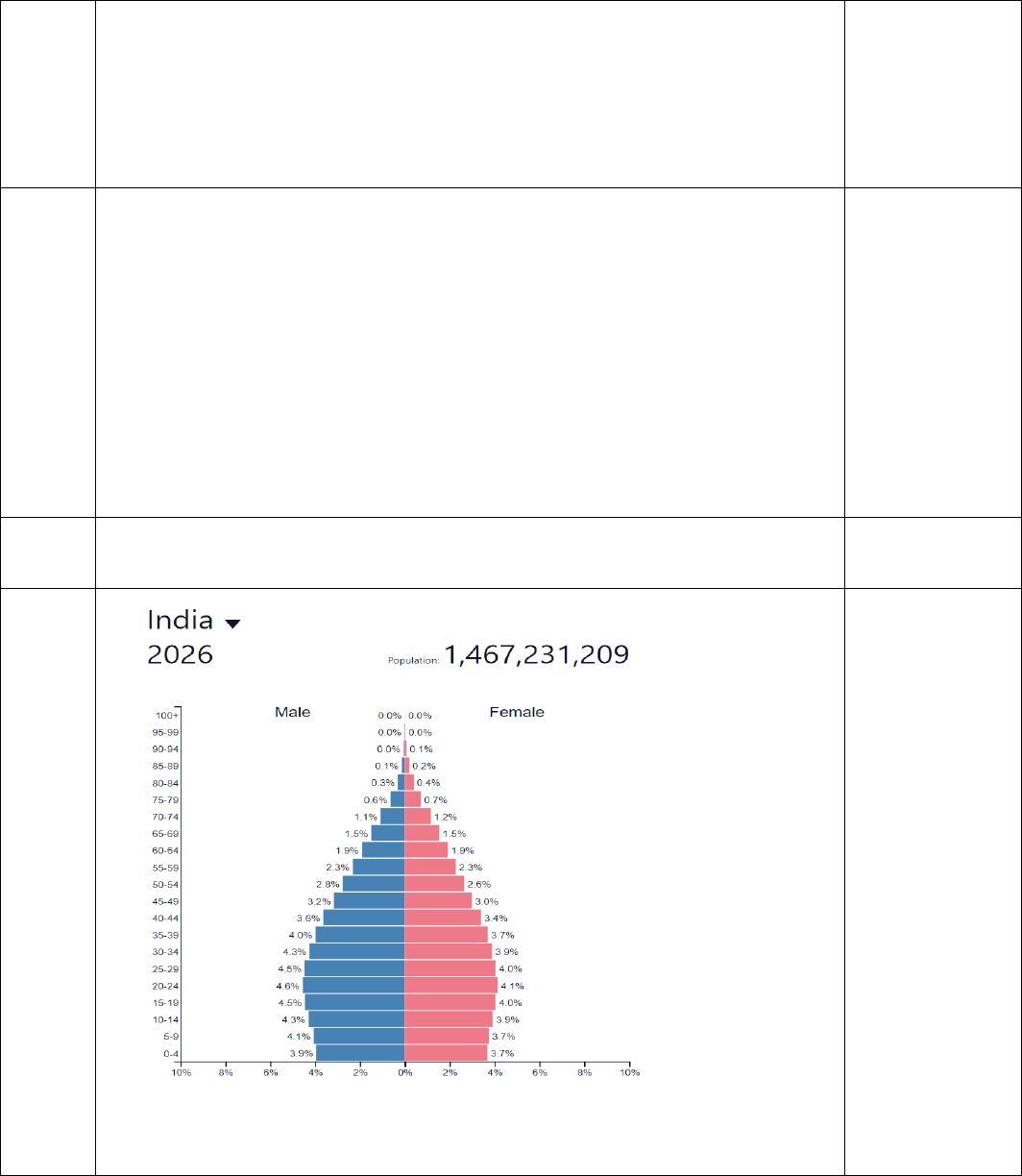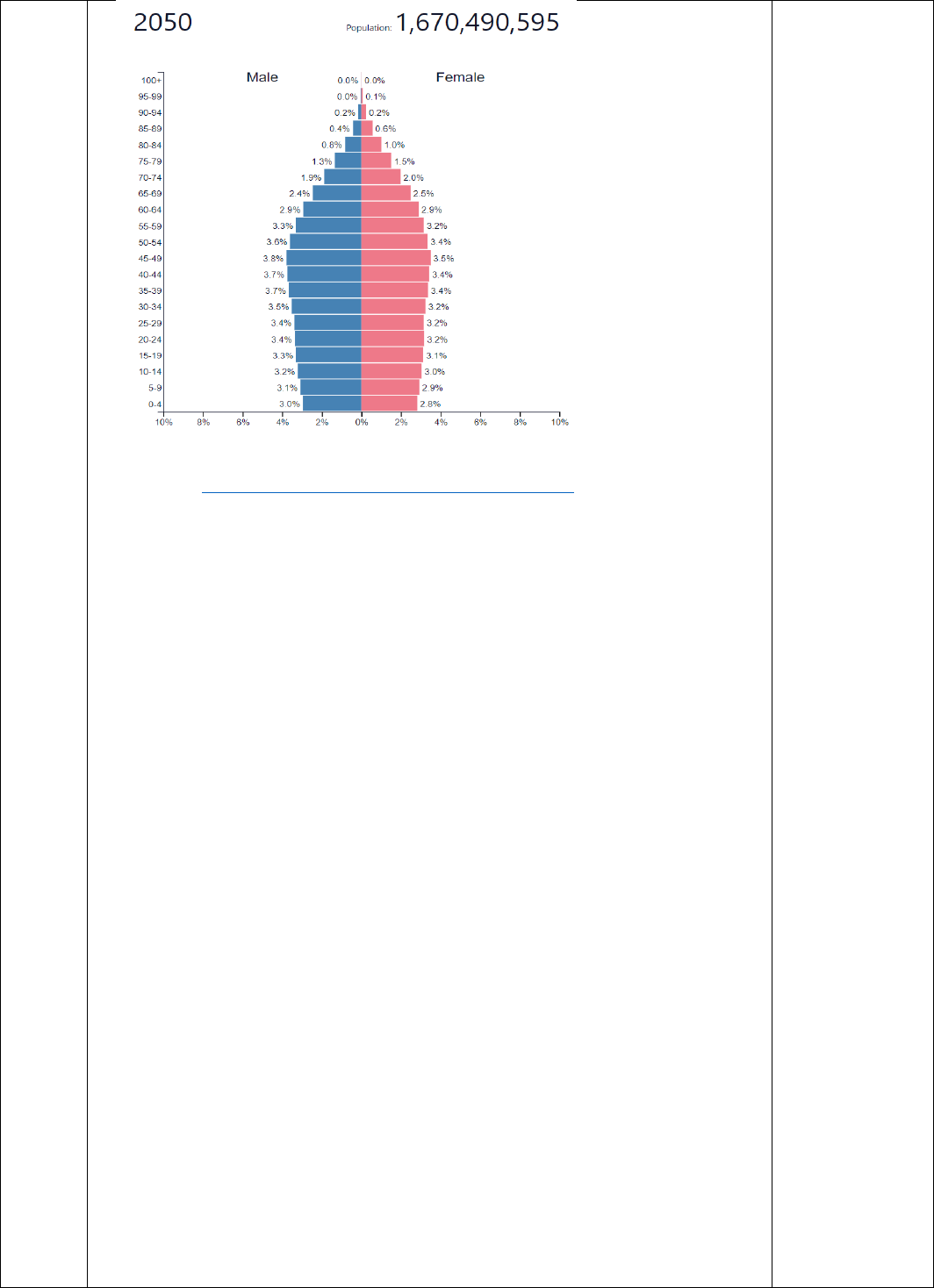
SOCIOLOGY (039)
SAMPLE QUESTION PAPER
MARKING SCHEME
CLASS XII 2023-24
S.No.
SECTION A
Marks
1.
Assertion (A): People often do not see the end result of their work
because they are producing only one small part of a product.
Reason(R): Industrialisation involves a detailed division of labour
where people do not enjoy work, and see it as something they have
to do only in order to survive.
a) Both A and R are true and R is the correct explanation of
A.
b) Both A and R are true but R is not the correct explanation of
A.
c) A is true but R is false.
d) A is false and R is true.
1(A)
2.
Which of the following stages, as per the Theory of Demographic
Transition, is that of high population growth?
a) First Stage
b) Both first and second stage
c) Second Stage
d) Third Stage
1(U)
3.
Which of the following statements is not true for the institution of caste
today?
a) some scholars argue that what we know today as caste is more a
product of colonialism than of ancient Indian tradition.
b) Counting and official recording of caste identities gave the
institution a new life.
c) The institution became extremely flexible.
d) Government of India Act of 1935 was passed which gave legal
recognition to the lists or ‘schedules’ of castes and tribes marked
out for special treatment by the state. This is how the terms
1(A)

‘Scheduled Tribes’ and the ‘Scheduled Castes’ came into being.
4.
Which of the following reasons are responsible for the invisibility of
the caste system in the upper castes and upper middle class?
a) Policy of reservation
b) Education and Employment in Private Sector
c) developmental policies of the post-colonial era
d) their lead over the rest of society (in terms of education) did not
ensure protection from serious competition
1(U)
5.
“Considering from an urban point of view, the rapid growth in
urbanization shows that the town or city has been acting as a magnet
for the rural population.” Choose the incorrect statement about
urbanization in India?
a) Rural- to- Urban migration has increased due to decline in
common property resources.
b) Urban areas are a decisive force in terms of political
dynamics.
c) People go to cities in search of work.
d) Cities offer anonymity to the poor and oppressed class.
1(CREATE)
6.
In which ways Adivasis struggles are different from Dalit struggle?
a) They were not discriminated against like the Dalits.
b) Their social and economic conditions were better than the Dalits
c) They did not face social exclusion like the Dalits.
d) Adivasis were concentrated in contagious areas and could
demand statehood
1(U)
7.
Stereotypes fix whole groups into single_______ categories, they
refuse to recognize the_______ across individuals and across
context or across time.
a) Homogeneous, variation
1(A)

b) Heterogeneous, similarities
c) Broad, similarities
d) Diverse, differences
8.
Person from a well-off family can afford expensive higher education.
Someone with influential relatives and friends may – through access
to good advice, recommendations or information – manage to get a
well-paid job.
Which concept is being talked of?
a) Forms of capital by Bourdieu
b) Resources by Bourdieu
c) Ideal types by Max Weber
d) Ideal Types by Bourdieu
1(A)
9.
Assertion(A): The everydayness of social inequality and exclusion
often make them appear inevitable, almost natural.
Reason(R): The common-sense understanding is that the poor and
marginalised are where they are because they are lacking in ability,
or haven’t tried hard enough to improve their situation.
a) Both A and R are true and R is the correct explanation of
A.
b) Both A and R are true but R is not the correct explanation of A.
c) A is true but R is false.
d) A is false and R is true.
1(A)
10.
Cultural diversity can present tough challenges. Which of the
following is not a reason for challenge?
a) It can arouse intense passions among its members and mobilise
large numbers of people
b) Economic and social inequalities among the communities.
c) Equal distribution of scarce resources- like river water, jobs
or governments funds.
d) Injustices suffered by one community provoke opposition from
same communities.
1(A)

11.
Policies promoting integration involve-
a) Outright suppression of identities of groups which are in
minority.
b) Complete erosion of cultural differences between groups.
c) Elimination of ethno-national and cultural differences from the
public arena.
d) All of the above.
1(A)
12.
Assertion (A): Urbanisation in the colonial period saw the formation
of new urban centres.
Reason (R): These urban centres were designed to functions as
trading posts alone.
a) Both A and R are true and R is the correct explanation of A.
b) Both A and R are true but R is not the correct explanation of A.
c) A is true but R is false.
d) A is false and R is true.
1(A)
13.
Assertion (A): The impact of Sanskritisation is many sided.
Reason (R): Its influence can be seen in language, literature,
ideology, music, dance, drama, style of life and ritual.
a) Both A and R are true and R is the correct explanation of A.
b) Both A and R are true but R is not the correct explanation of A.
c) A is true but R is false.
d) A is false and R is true.
1(A)
14.
Major difference between developing and developed countries is in
the number of people in ___________salaried employment.
a) Daily Wages
b) Regular
1(U)

c) Irregular
d) Both b) & c)
15.
The Right to Information campaign is an example of ____________.
a) Redemptive Movement
b) Reformist Movement
c) Revolutionary Movement
d) Old Social Movement
1(U)
16.
Which of the following is not a feature of social movements?
a) Sustained collective action
b) Aims to bring about changes on a public issue
c) Shared objectives and ideologies
d) Does not need leadership or structure
1(U)
SECTION-B
17.
In Modern Foods, which was set up by the government to make
healthy bread available at cheap prices, and which was the first
company to be privatised, 60% of the workers were forced to retire
in the first five years.
Based on the given passage, answer the following question.
How did disinvestment impact the workers?
Sale of share in public sector companies.
Loss of jobs; reduction in employees
(OR)
“In Maruti Udyog Ltd. two cars roll off the assembly line every minute.
Workers get only 45 minutes rest in the entire day - two tea breaks
of 7.5 minutes each and one lunch break of half an hour. Most of
them are exhausted by the age of 40 and take voluntary retirement.”
Based upon above passage, answer the following question.
What, according to you, is the impact of the factory’s working
condition on the workers and on the factory?
Impact on the factory
Cost cutting allows for profit
Reduction in number of permanent employees Impact on worker
2(CREATE)

More people opting for voluntary retirement
Reduction in number of permanent employees
Workers are always very tense due to practices such as just-intime
and outsourcing
18.
Many of our cultural practices and patterns can be traced to our
agrarian backgrounds. Give two examples.
Most of the new year festivals in different regions of India such as
Pongal in Tamil Nadu, Bihu in Assam, Baisakhi in Punjab celebrate
the main harvest reason
herald the beginning of new agricultural season
2(U)
19.
Using an example, describe adivasis internal colonialism.
After independence, government monopoly over forests
continued.
Adivasi land acquired for mining and dam projects in the name
of national development.
Sardar Sarovar Dam project
2(A)
20.
With an example show how being a minority group can be
disadvantageous in one sense but not in another.
Example-Parsis and Sikhs
Economically well-off
Culturally disadvantaged due to overwhelming majority of
Hindus
2(U)
21.
The 1989 Prevention of Atrocities Act revised and strengthened the
legal provisions punishing acts of violence or humiliation against
Dalits and adivasis. Legislation on this subject was passed
repeatedly.
Do you think state action alone can ensure social change? Give
reasons for your answer.
No
Human beings are always capable of organising and acting
on their own to struggle for justice and dignity.
2(A)

This is needed to bring about attitudinal change.
22.
City offers relative anonymity to those migrating to it. What do you
mean by relative anonymity?
Poorer sections would not be known by ascriptive identities
Partial protection to socially oppressed
Poorer sections of socially dominant groups can engage in low
status work
2(A)
23.
“If hard labour were such a good thing the rich would keep it all for
themselves. All over the world, back-breaking work like stone
breaking, digging, carrying heavy weights, pulling rickshaws or carts
is invariably done by the poor. And yet they rarely improve their life
chances.”
Which social phenomena is reflected in this proverb? Give any two
characteristics of this phenomena.
Social stratification
Characteristics-persists over generations; based on a beliefs;
not a function of individual difference (any two)
2(CREATE)
24.
Rabindranath Tagore on the evils of exclusive nationalism …where
the spirit of the Western nationalism prevails, the whole people is
being taught from boyhood to foster hatred and ambitions by all
kinds of means -- by the manufacture of half-truths and untruths in
history, by persistent misrepresentation of other races and the
culture of unfavorable sentiments towards them…Never think for a
moment that the hurt you inflict upon other races will not infect you,
or that the enmities you sow around your homes will be a wall of
protection to you for all time to come? To imbue the minds of a whole
people with an abnormal vanity of its own superiority, to teach it to
take pride in its moral callousness and I’ll be gotten wealth, to
perpetuate humiliation of defeated nations by exhibiting trophies
won from war, and using these schools in order to breed in children’s
minds contempt for others, is imitating the West where she has a
festering sore…
Source: On Nationalism by Rabindranath Tagore. First published in
1917, Reprint Edition of Macmillan, Madras 1930.
Read the passage and show any two ways in which exclusive
nationalism is practiced.
Manufacture of half-truths and untruths in history.
2(CREATE)

Misrepresentation of other races
Culture of unfavorable sentiments towards other races
Perpetuate humiliation of defeated nations by exhibiting
trophies won from war
Using schools to breed in children’s mind contempt for others.
(OR)
Is statehood always based on linguistic identity? Give reasons for
your answer.
No. Combination of ethnicity based on tribal identities, language,
regional deprivation and ecology provides the basis for intense
regionalism resulting in statehood.
25.
In what ways have social movements shaped the world we live and
continue to do so?
Work day should not exceed 8 hours.
Men and women should be paid equally for doing the same
work.
Workers are entitled to social security and pension.
(any two)
2(U)
SECTION-C
26.
Kumudtai’s journey into Sanskrit began with great interest and
eagerness with Gokhale Guruji, her teacher at school… At the
University, the Head of the Department was a well-known scholar
and he took great pleasure in taunting Kumudtai…Despite the
adverse comments she successfully completed her Masters in
Sanskrit…. Source: Kumud Pawade (1938)
What does Kumud Pawade’s autobiography show us about the
relation between gender and caste?
Dalit woman became a Sanskrit teacher
As a student she is drawn towards the study of Sanskrit,
perhaps because it is the means through which she can break
into a field that was not possible for her to enter on grounds of
gender and caste.
she was drawn towards it because it would enable her to read
in the original what the texts have to say about women and
the Dalits.
As she proceeds with her studies, she meets with varied
reactions ranging from surprise to hostility, from guarded
acceptance to brutal rejection.
4(U)

27.
The post independent Indian state’s caste considerations had some
contradictions. What were these contradictions?
State was committed to the abolition of caste
State was both unable and unwilling to push through radical
reforms which would have undermined the economic basis of
caste inequality.
State assumed that if it operated in a caste-blind manner, it
would undermine caste -based privileges and eventual
abolition.
Appointment to govt. jobs took no account of caste, leaving
illiterate lower caste and well-educated upper caste to
compete on equal terms.
(OR)
What are the factors behind the assertion of tribal identity today?
tribal identities today are centred on ideas of resistance and
opposition to the overwhelming force of the non-tribal world
The positive impact of successes – such as the achievement
of statehood for Jharkhand and Chattisgarh
gradual emergence of an educated middle class among tribal
communities
issues relating to control over vital economic resources like
land and specially forests, and issues relating to matters of
ethnic-cultural identity
4(A)
28.
Using an example, show how the treatment of Indian plantation labour
was different from the way colonial administration treated their own
labour back home.
people brought from far-off homes into strange lands,
possessing an unhealthy climate and infected with strange
fevers,
Required the provision of financial and other incentives, which
the tea-planters of Assam were unwilling to offer.
Planters took recourse to fraud and coercion
Planters persuaded the government to aid and abet them
passing penal laws
4(A)
29.
“Every human being needs a sense of stable identity to operate in this
world. Questions like — Who am I? How am I different from others?
How do others understand and comprehend me? What goals and
aspirations should I have? – constantly crop up in our life right from
childhood. We are able to answer many of these questions because
4(A)

of the way in which we are socialised, or taught how to live in society
by our immediate families and our community in various senses.”
During a communal conflict, communities construct matching but
opposite mirror images of each other. Explain this statement.
Each side in the conflict thinks of the other side as a hated
enemy
tendency to exaggerate the virtues of one’s own side as well
as the vices of the other side
each side believes that God and truth are on their side
when two nations are at war, patriots in each nation see the
other as the enemy aggressor
30.
“Green Revolution of the 1960s and 1970s brought about significant
changes in the areas where it took place. The Green Revolution, as
you know, was a government programme of agricultural
modernisation. It was largely funded by international agencies that
was based on providing high-yielding variety(HYV) or hybrid seeds
along with pesticides, fertilisers, and other inputs, to farmers.”
Was Green Revolution always accompanied by positive social
effects? Give reasons for your answer.
No
primarily the medium and large farmers who were able to
benefit from the new technology
increasing inequalities in rural society
displacement of the service caste groups
market oriented cultivation, especially where a single crop is
grown, a fall in prices or a bad crop can spell financial ruin for
farmers
worsening of regional inequalities
(any 4)
4(A)
31.
“The structure of the family can be studied both as a social institution
in itself and also in its relationship to other social institutions of
society.” Elaborate.
work schedules of young parents in the software industry
changes are purposely brought about, as when young people
decide to choose their spouses instead of letting elders decide
4(U)

migration of men from the villages of the Himalayan region can
lead to an unusual proportion of women-headed families in the
village
when young people decide to choose their spouses instead of
letting elders decide
32.
The agrarian structure becomes more unequal with high agricultural
productivity. Explain with a suitable example.
Places with plentiful rain and assured irrigation have intensive
agriculture
More labour needed
Labour predominantly from lower caste
Agrarian structure of such regions unequal because they had
large numbers of landless bonded labourers
4(CREATE)
SECTION-D
33.
6(A)

(Source: https://www.populationpyramid.net/india)
Based on the given Population Pyramids of India for the year 2026
and 2050, answer the following questions.
a) What is demographic dividend?
benefit flowing from the changing age structure
b) What do you infer, on comparing the given graphics for the age
group of 55-59 and 60-64?
Population in the 55-59 age range is decreasing and that in the
60-64 age range is increasing.
c) What, according to you, are the implications of this inference?
India must utilize the potential of people in the working age-group
before the demographic window closes.It must also introduce
policy changes to provide social security for the increasing
number of senior citizens.
(Q 33. FOR CANDIDATES WITH VISUAL IMPAIRMENT)
The Population Pyramid of India for the year 2050 indicates that the
male and female population in the age range of 60-64 stands at
2.9% and the male and female population in the age range of 55-
59 stands at 3.3% and 3.2% respectively.

The Population Pyramid of India for the year 2026 indicates that the
male and female population in the age range of 60-64 stands at
1.9% and the male and female population in the age range of 55-
59 stands at 2.3%.
Based on this data, answer the following questions.
a) What is demographic dividend?
Answer same as above
b) What do you infer, on comparing the given data for the age
group of 55-59 and 60-64?
Answer same as above
c) What, according to you, are the implications of this inference?
Answer same as above
34.
“Niyamgiri Hills is home to Dongria Kondh, a particularly vulnerable
tribal group, who had unanimously voted against a project by state
government-owned Odisha Mining Corporation (OMC) and Sterlite
Industries which wanted to mine bauxite. The villages’ decision
followed a landmark Supreme Court verdict on April 18, 2013, that
vindicated the decade-long movement. The court said forest
clearance for the mining project, which had been withdrawn by the
Environment Ministry in 2010, could be given only after taking the
consent of the gram sabhas, or village councils, in the region in
tandem with the Forest Right Act (FRA).”
(Source: Development At Cost Of Human Lives? Revisiting Adivasi
Resistance In Mali Parbat, Niyamgiri Hills, Shreya Basak, 19 Jan
2023 12:29 PM, Outlook)
Based on the given passage, answer the following questions.
a) What is a social movement?
Sustained collective action, with shared ideology and goals, with
some degree organization, to demand changes in state policy.
b) Based on your reading of the passage, identify the issues that
the social movement addresses.
Identity and cultural practices of tribals; ecological issues.
c) Would you classify this social movement as old or new? Give
6(CREATE)

reasons for your answer.
New Combination of class and quality of life issues; not localized
and not within the frame of political parties.
35.
What changes did globalization and liberalization introduce in the
Indian industrial society?
Private companies, especially foreign firms, are encouraged to
invest in sectors earlier reserved for the government, including
telecom, civil aviation, power, etc.
Licenses are no longer required to open industries.
Disinvestment
Indian companies are becoming multinational companies
Indian companies being bought over by multinational
companies
Outsourcing
6(U)
